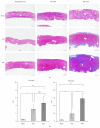Novel Model of Pulmonary Artery Banding Leading to Right Heart Failure in Rats
- PMID: 26504827
- PMCID: PMC4609378
- DOI: 10.1155/2015/753210
Novel Model of Pulmonary Artery Banding Leading to Right Heart Failure in Rats
Abstract
Background: Congenital heart diseases often involve chronic pressure overload of the right ventricle (RV) which is a major cause of RV dysfunction. Pulmonary artery (PA) banding has been used to produce animal models of RV dysfunction. We have devised a new and easier method of constricting the PA and compared it directly with the partial ligation method.
Methods: Eight-week-old male Sprague-Dawley rats (240-260 g) were divided into three groups: sham operation, partial pulmonary artery ligation (PAL) procedure, and pulmonary artery half-closed clip (PAC) procedure. RV function and remodeling were determined by echocardiography and histomorphometry.
Results: Surgical mortality was significantly lower in the PAC group while echocardiography revealed significantly more signs of RV dysfunction. At the 8th week after surgery RV fibrosis rate was significantly higher in the PAC group.
Conclusions: This procedure of pulmonary artery banding in rats is easier and more efficient than partial ligation.
Figures






References
-
- Faber M. J., Dalinghaus M., Lankhuizen I. M., et al. Right and left ventricular function after chronic pulmonary artery banding in rats assessed with biventricular pressure-volume loops. American Journal of Physiology—Heart and Circulatory Physiology. 2006;291(4):H1580–H1586. doi: 10.1152/ajpheart.00286.2006. - DOI - PubMed
MeSH terms
LinkOut - more resources
Full Text Sources
Other Literature Sources
Medical

